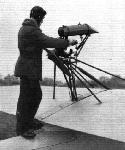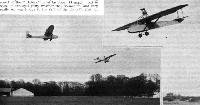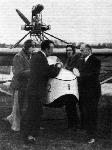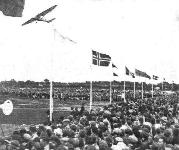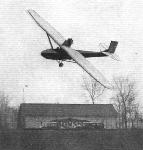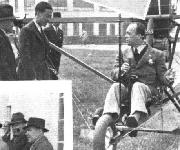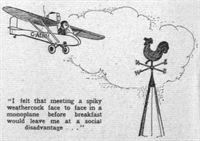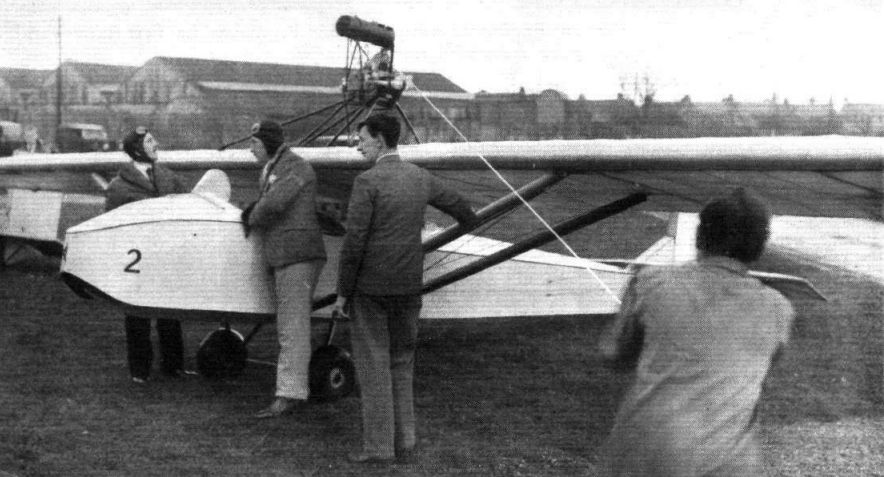
Варианты
- Lowe-Wylde - Columbus / BAC.II - BAC.IX - 1930 - Великобритания
- Kronfeld - Drone - 1932 - Великобритания
- SFAN - SFAN 5 - 1936 - Франция
Kronfeld Drone и Monoplane
В течение 1932 года К. X. Лоув Уайлд - управляющий директор и конструктор компании "British Aircraft Company" (город Майдстоун, графство Кент) - спроектировал на базе одного из выпускавшихся компанией планеров легкий самолет, получивший обозначение BAC Planette. Однако в мае 1933 года сам Лоув Уайлд погиб во время происшествия с одним из таких самолетов, после чего его должность занял Роберт Кронфельд, знаменитый в те годы пилот-планерист, австриец по происхождению. В 1936 году компания была переименована в "Kronfeld Ltd", а самолет - модифицирован и переименован в Kronfeld Drone. Всего было построено 33 таких легких самолета, включая несколько машин под обозначением Drone de Luxe - они имели крыло с небольшой стреловидностью и щелевые элероны. В 1937 году был построен и облетан новый самолет Kronfeld Monoplane, в целом конструктивно схожий с модификацией Drone, но оснащенный двигателем Carden-Ford мощностью 30 л. с. и новым хвостовым оперением.
Описание:
- Kronfeld Drone и Monoplane
- Flight, September 1935
FLYING the NEW DRONE - Flight, April 1936
MODERN LIGHT AIRCRAFT REVIEWED
Фотографии
-
Flight 1932-12 / Flight
STARTING UP: By pulling a wire wound round a drum behind the engine.
-
Flight 1932-11 / Flight
THE LATEST TREND: Mr. Lowe-Wylde - as usual pioneering - with his latest venture. He has, for experimental purposes only, added a motor-cycle engine to his B.A.C. VII two-seater and has already done a considerable amount of successful flying with this combination.
-
Flight 1932-12 / Flight
THE POWER UNIT: A close-up showing the little Douglas on its mounting and the petrol tank above it.
-
Flight 1932-12 / Flight
THE "AIR BABIES" IN FLIGHT: On the left, the two "in formation," and on the right Capt. Ayre in the air.
-
Aeroplane Monthly 1974-11 / J.Wood - Seventy hours of Dronish delight
The four Pianettes, numbered 1 to 4, during a demonstration at Hanworth in November 1932, The Planette was the forerunner of the Drone and was powered by a 600 c.c. Douglas flat-twin motor cycle engine.
-
Aeroplane Monthly 1974-11 / J.Wood - Seventy hours of Dronish delight
A Pianette at Hanworth in 1932.
-
Aeroplane Monthly 1974-11 / J.Wood - Seventy hours of Dronish delight
C. H. Lowe Wylde demonstrates the single-seat prototype Planette No 1. He later died in this aircraft when it sideslipped into the ground from 400ft.
-
Flight 1932-12 / Flight
BABY TALK: From left to right, Capt. E. D. Ayre, the Master of Sempill, Mr. Lowe-Wylde, and Mr. Gordon England.
-
Flight 1933-08 / Flight
THE B.A.C. "DRONE" IN BELGIUM: Here is a snap of the first "Drone" to be built in Belgium.
-
Aeroplane Monthly 1987-10 / Personal album
Регистрационный номер: G-AEAN [2] Drone G-AEAN was short lived. Registered in January 1936, it flew with C.W.A. Scott's circus that season but crashed at Southend on July 22, 1936.
-
Flight 1936-01 / Flight
Регистрационный номер: G-ADUA [2] PRACTICAL PROOF: On December 20 Mr. Robert Kronfeld delivered a B.A.C. Super Drone to Holland and flew well over 200 miles non-stop in the process. He left Hanworth at 10.30, cleared Customs at Croydon and landed eventually at Zierikzee, some twenty miles from Rotterdam. The weather was foggy and cold, but, with the new exhaust-warmed induction system, no trouble was experienced. In this photograph the Super Drone is being demonstrated by Mr. Kronfeld at Schiphol, Amsterdam.
-
Aeroplane Monthly 1974-11 / J.Wood - Seventy hours of Dronish delight
Регистрационный номер: G-AEJH [2] The subject of this article, BAC Drone G-AEJH, and the author at Sywell, Northamptonshire.
-
Aeroplane Monthly 1984-09 / P.Jarrett - Grapevine
Регистрационный номер: G-AEKV [2] Ron Paine renews his acquaintance with Drone De Luxe G-AEKV at Brooklands on July 10, 1984. He last sat in its cockpit in the mid-1980s. Carden Ford-engined ’EKV should be back in the air shortly.
-
Aeroplane Monthly 1994-04 / 1994 UK Aircraft Collections and Museums Guide
Регистрационный номер: G-AEKV [2] Kronfeld Drone de Luxe G-AEKV is preserved at the Brooklands Museum.
-
Flight 1935-06 / Flight
Mr. E. D. Ayre sets off, pipe in mouth, to give a demonstration of the impossible - with the B.A.C. "Drone."
-
Flight 1935-09 / Flight
Регистрационный номер: G-ADPJ [8] A number of modifications, together with the use of a 750 c.c. Douglas engine, result in a considerably enhanced performance and improved control for the Super Drone. Mr. Kronfeld demonstrates its controllability at Hanworth.
-
Flight 1935-11 / Flight
Регистрационный номер: G-ADPJ [8] "If we are to sit in front of the wing, why not put the engine behind, Drone-fashion?"
-
Flight 1935-03 / Flight
FOR "SPORT-FLYING": Under the management of Mr. R. Kronfeld, production of the "Drone," an ultra-light aeroplane (600 c.c, 14 h.p. Douglas engine) has been resumed at Hanworth by B.A.C. Ltd. The machine was first designed by the late Mr. C. H. Lowe-Wylde. Mr. Kronfeld shortly hopes to make some long flights with the "Drone," which is a machine that should be most suitable for recreational flying and will be seen at most flying clubs during the coming season.
-
Flight 1936-04 / Flight Advertisements
Регистрационный номер: G-ADPJ [8] -
Aeroplane Monthly 1974-11 / J.Wood - Seventy hours of Dronish delight
Регистрационный номер: G-ADPJ [8] Another Drone, G-ADPJ.
-
Flight 1935-09 / Flight
Регистрационный номер: G-ADPJ [8] The B.A.C. Super Drone is an ultra light pusher type, in which the pilot has a very excellent view.
-
Aeroplane Monthly 1987-10 / Personal album
Регистрационный номер: G-AEKT [4] Drone G-AEKT was registered to the parent company in November 1936 and survived until the war.
-
Aeroplane Monthly 1974-11 / J.Wood - Seventy hours of Dronish delight
Регистрационный номер: G-ADPJ [8] FRESH FROM THE HIVE. A greatly improved version of the B.A.C. Drone has been produced and is seen here in a spirited zoom at Hanworth. The wings are now arranged to fold and there is tankage for 5 1/2 hours' fuel. Cruising and maximum speeds are respectively 60 m.p.h. and 70 m.p.h.
Robert Kronfeld climbs steeply away in the Drone G-ADPJ. -
Aeroplane Monthly 1974-11 / J.Wood - Seventy hours of Dronish delight
Регистрационный номер: G-ADPJ [8] A striking "angle" on the B.A.C. Super Drone which cruises at 60 m.p.h. with a 750 c.c. engine.
Cdr J. S. Dove RN's Drone G-ADPJ. -
Aeroplane Monthly 1974-11 / J.Wood - Seventy hours of Dronish delight
Регистрационный номер: G-AFBZ [2] G-AFBZ again.
-
Flight 1936-05 / Flight
The Rolls-Royce Heinkel (four passengers and two pilots), which is credited with a speed of 240 m.p.h. from the Kestrel engine. In the air is the B.A.C. Super Drone.
Другие самолёты на фотографии: Heinkel He-70/Не-170 Blitz - Германия - 1932
-
Flight 1936-09 / Flight
An impression from the inside of the London Club's hangar while the four Drones (two of them to be seen) shoot-up the surrounding landscape. A part of the Club fleet stands without.
-
Flight 1936-06 / Flight
The enclosures were decorated with the flags of all nations whose countries are linked to our own by the routes of British Airways Ltd. In the air is Mr. Kronfeld's Drone.
-
Flight 1934-05 / Flight
M. Manchoulas coming in to land at Le Bourget after his flight from Ghent in the Scorpion-engined power glider.
-
Flight 1936-04 / Flight
Регистрационный номер: G-AEAN [2] "- nothing up my sleeve." Mr. Idwal Jones demonstrates the docility of the B. A. C. Drone.
-
Aeroplane Monthly 1974-11 / J.Wood - Seventy hours of Dronish delight
Регистрационный номер: G-AEJH [2] The author indulges in a low flypast in his Drone.
-
Flight 1934-06 / Flight
The Belgian B.A.C. "Drone" on a sharp turn.
-
Flight 1937-11 / Flight
Регистрационный номер: G-AFBZ [2] Самолет Drone представлял собой планер, оснащенный мотоциклетным двигателем Douglas.
G-AFBZ, powered by a 35 h.p. Ava flat-four motor, was built for Lord Sempill.
A number of different engines have been fitted to the various Drone developments. This particular model has a flat-four two-stroke Ava. -
Flight 1937-05 / Flight
Makers of light plane history. The first attempt to revive interest in the "ultra light" was the Lowe-Wylde (now Kronfeld) Drone, seen here.
-
Flight 1935-05 / Flight
IT COULDN'T BEAT THE "DRONE.'' Rain and generally dirty weather failed to prevent Mr. Kronfeld reaching Paris in the "Drone." Here the tiny machine is seen just prior to starting from Croydon.
-
Air-Britain Archive 1981-01
Регистрационный номер: G-ADSB Recent correspondence from Bob Ogden on the subject of Drones reminded the Editor of this example. Why was it painted in this manner? Whose Drone was it and what was the registration?
The Drone G-ADSB flown by Bernard Collins in British Hospitals Air Pageants. -
Air-Britain Archive 1988-04
Регистрационный номер: G-AEKT [4] Drone G-AEKT as PR-? flown by 609 Sqdn pilots during 1940/1.
-
Flight 1935-05 / Flight
A section of the long line of machines on exhibition. In the foreground is the B.A.C. "Drone," then a Spartan "Cruiser," a Railway Air Services D.H.86, the K.L.M. Douglas D.C.2, and others.
Другие самолёты на фотографии: De Havilland Express Air Liner / D.H.86 - Великобритания - 1934Douglas DC-1 / DC-2 / C-32 / C-39 - США - 1933Spartan Cruiser - Великобритания - 1932
-
Flight 1936-04 / Flight
The Fleet: Miss Joan Meakin's Wolf glider, the Airspeed Ferry, and the B.A.C. Drone are in the foreground.
Другие самолёты на фотографии: Airspeed Ferry / AS.4 - Великобритания - 1932Goppingen Go.1 Wolf - Германия - 1935
-
Flight 1936-09 / Flight
LULL IN THE STORM: Varied fauna at the Bristol club's garden party last Saturday, which suffered severely from the weather. Seen here are one of the Club Swallows, the Bristol 143, an Autogiro, a Drone, and three Harts of No. 501 (City of Bristol) Squadron. The human element is mainly seeking solace in the clubhouse, which, with the Airwork hangar, can be seen in the background.
Другие самолёты на фотографии: Bristol Type 142 Britain First / Type 143 - Великобритания - 1935British Klemm L.25 Swallow - Великобритания - 1933Cierva/Avro C.30A / Rota - Великобритания - 1932Hawker Hart - Великобритания - 1928
-
Air-Britain Archive 1988-04
Регистрационный номер: G-AEKT [4] Drone G-AEKT photographed in 1937 at 'Carswell Manor' (possibly Carswell in Oxfordshire?) with an Aeronca and a Gipsy Moth possibly G-ABOE of the Misses Glass with number 57 on the tail.
Другие самолёты на фотографии: Aeronca C - США - 1929De Havilland Gipsy Moth / Moth X - Великобритания - 1928
-
Flight 1935-09 / Flight
Регистрационный номер: G-ADPJ [8] Not quite so startling as it appears - merely the Super Drone with its wings folded, thus reducing the width for housing purposes to 10 ft. Note the wide undercarriage.
-
Flight 1936-04 / Flight
The 750 c.c. Douglas engine of the type used in the Drone.
-
Flight 1936-09 / Flight
DRONE-DRIVER: The installation of the 30 h.p. water-cooled Carden in a new version of the Kronfeld Super Drone.
-
Flight 1937-09 / Flight
NEW POWER FOR THE DRONE: How the flat-four Ava two-stroke engine is arranged in Lord Sempill's new Drone. The airscrew is well clear of the cut-away trailing edge and the engine turns over at only 2,100 r.p.m., so the familiar noise is no longer heard; this machine has, in fact, that quality of quietude which should add greatly to the pleasure of what is now rather more than "Drone-floating." The price of this model has been fixed at ?325 with full equipment.
-
Flight 1936-04 / Flight
PROOF: Lord Sempill's flight to Berlin (11 hours) and back (9 hours) in a B.A.C. Super Drone must have given a jolt to those who habitually scoff at ultra-light aircraft. Lord Sempill is seen at Croydon with Mr. Kronfeld (right).
-
Flight 1936-11 / Flight
ONE OF THE LADS: A familiar overalled figure at Hanworth these days is the Baroness Rudoleine von Simolin, 17-year-old daughter of one of Germany's biggest chemical manufacturers. She is now serving a hard-working apprenticeship at the Kronfeld factory at Hanworth, and is seen here in front of the Carden-engined Drone.
-
Aeroplane Monthly 1994-04 / B.MacGowan - Tailless tales
Robert Kronfeld, left, briefing Gp Capt Edward Mole before a flight in the prototype BAC Drone in 1933.
-
Flight 1935-09 / Flight
Mr. Robert Kronfeld, managing director of B.A.C. (1935) Ltd., in the cockpit of the Super Drone. With him are Mr. E. C. Gordon England (director) and on the left, the latter's brother, Sqn. Ldr. T. H. England.
-
Flight 1936-12 / Flight
Регистрационный номер: G-ADUA [2] ULTRA-LIGHT LUXURY: A totally enclosed and exhaust-heated cockpit has been designed for a special Kronfeld Drone recently produced to the order of a private owner, Mr. R. Dimock. It will be noticed that this machine also has a rubber-sprung split-axle undercarriage and the latest exhaust system. Mr. Dimock will not be likely to lose his hat again, (as once happened, with catastrophic results) while flying this machine.
-
Aeroplane Monthly 1982-12 / Hanworth /Gone but not forgotten/ (14)
Регистрационный номер: G-AEKU [3] Drone G-AEKU lands behind the Kronfeld Tutorplane.
-
Flight 1936-12 / Flight
Регистрационный номер: G-AEKU [3] UNDERGRADUATION: Mr Kronfeld taxies his new "flying" ground trainer at Hanworth while the latest type of Carden-engined Drone De Luxe flies overhead. The standard De Luxe model costs L325, while the ground trainer is priced at L195. The Country Flying Club, of Leicester, charge 9s. an hour for instruction on the normal ground trainer which they have been using successfully for the past month or two.
-
Flight 1937-05 / Flight
"DIVINE WIND'S" crew see something of British aviation: Messrs. Iinuma and Tsukagoshi, famed for their 100-hour flight from Tokio, recently enjoyed the hospitality of that section of the Industry which centres on Hanworth. They are seen greatly intrigued by Mr. Kronfeld's exposition of his ground trainer.
-
Aeroplane Monthly 1976-10 / A.Ord-Hume - Kronfeld monoplane /British pre-war ultralights/
Регистрационный номер: G-AEKT [4] Front to rear. Lord Sempill’s special 35 h.p. Ava-powered Drone, the Kronfeld Monoplane, Kronfeld ground trainer and two Carden-Ford powered Drones. The way in which the Monoplane’s engine was moved rearwards to clear the wing can be compared with the large trailing edge cutout in the Drone.
-
Flight 1938-09 / Flight
The tricycle Drone mentioned by Mr. Dimock in his letter.
-
Air-Britain Archive 1983-01
Регистрационный номер: G-AEDB Drone G-AEDB, date and place unknown, but thankfully airworthy once more since 1981.
-
Aeroplane Monthly 1976-10 / A.Ord-Hume - Kronfeld monoplane /British pre-war ultralights/
Регистрационный номер: G-AESG [3] The Kronfeld Monoplane makes its public debut at the RAeS Heathrow Garden Party on May 9, 1937.
-
Aeroplane Monthly 1976-10 / A.Ord-Hume - Kronfeld monoplane /British pre-war ultralights/
Регистрационный номер: G-AESG [3] The Kronfeld Monoplane is seen there, serving as a makeshift rain shelter.
-
Aeroplane Monthly 1976-10 / A.Ord-Hume - Kronfeld monoplane /British pre-war ultralights/
Регистрационный номер: G-AESG [3] A rare picture of the Monoplane in flight, taken once again at the 1937 Garden Party.
-
Aeroplane Monthly 1987-10 / Personal album
Cockpit and sparse instrument panel of a Kronfeld Drone.
-
Flight 1936-04 / Flight
Pilot's view of the Super Drone. On the left are the controls, the very full array of instruments and the cockpit layout.
-
Flight 1937-03 / Flight
The Drone pilot has an excellent view and is free of airscrew slipstream.
-
Aeroplane Monthly 1988-03 / J.Battison - Flea circus
Регистрационный номер: G-AEDC The BAC Drone G-AEDC at Canute Air Park, with the fabric burnt away from its port wing. While taxying, the Drone's fuel pipe broke. The carburettor starved and spat indignantly, and the escaping fuel ignited.
-
Aeroplane Monthly 1996-08 / Painted Wings
Регистрационный номер: G-AUPJ Brian Withams’s portrayal of a Kronfeld Drone over the English Channel in the Thirties.
-
Flight 1939-06 / Flight
Регистрационный номер: G-AEKU [3] "I felt that meeting a spiky weathercock face to face in a monoplane before breakfast would leave me at a social disadvantage ..."
- Фотографии


